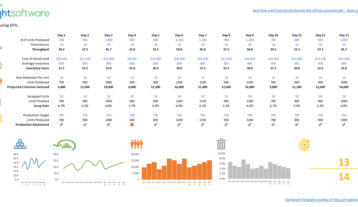Agile Reporting for the Manufacturing Industry: 5 Tips for Success

In the midst of massive unexpected change, the organizations that thrive and prosper will be the ones that can adapt most rapidly. As supply chains shift to address unexpected requirements, agility is quickly becoming the hallmark of organizations that can create value and make a meaningful difference in the world. A relatively new concept called “agile finance”—along with its key ingredient “agile reporting”—is empowering businesses to make that shift.
Agile Reporting: Speed with Control
View Whitepaper NowWhat Is Agile?
In 2001, a group of software developers got together at a ski resort in the Wasatch mountains of Utah and drew up a document they called the “Agile Manifesto.” The document was created as an answer to the traditional “waterfall” approach to software development, in which requirements are established at the beginning of a project and remain more or less static throughout the remainder of the process.
The authors of the Agile Manifesto outlined twelve principles aimed at helping software development teams deliver maximum value in the shortest possible time frame. They eschewed top-down management in favor of collaboration, bottom-up empowerment, customer-focused design, and responsiveness to rapidly changing requirements. They rejected the classic waterfall model of software development in favor of an iterative approach in which initial prototypes are delivered and tested early in the process. This allowed for rapid feedback and better responsiveness to the requirements of end-users.
What Does Agile Mean for Finance and Accounting?
The principles of agile development have been adapted to finance and accounting under the name “agile finance.” This new approach requires a rapid feedback loop. For an organization to respond quickly in a changing environment, stakeholders throughout the business must have real-time access to information about the internal workings of the organization and the environment in which it operates.
Manufacturers have always grappled with changing demand. Planning tools have become a standard part of the toolkit for manufacturing companies. In the digital age, the amount of information driving demand forecasts has increased, and demand data has flowed faster and more efficiently than ever before. However, when unexpected events disrupt the reliability of supply chains and demand forecasts, manufacturers need to be ready to shift at a moment’s notice. Enter agile reporting. Timely access to accurate information is the starting point for transforming the way your enterprise works.
Every organization is different, so rolling out agile principles in your organization may look very different from the business down the street. Nevertheless, there are some key principles that apply to virtually any manufacturer. These five tips will help you transform your manufacturing business to roll out agile principles in your company.
#1: Empower the End-User
Curtis Carlson, CEO of SRI International, once said that “top-down innovation is orderly but dumb, bottom-up innovation is chaotic but smart.” Agile finance dictates that to unleash innovation and maximize responsiveness, organizations must empower their end-users to think quickly and act independently. That means fast, flexible, and accurate reporting.
Information is the lifeblood of any modern organization, and finance teams are all about managing a company’s flow of information as accurately and efficiently as possible. Front-line users in finance and accounting must have the power and flexibility to tap into the organization’s data without relying on outside help from IT specialists. When finance has full ownership of report design, it can act quickly to respond to changing requirements.
#2: Eliminate Silos
Agile principles decry top-down management and rigid organizational structure in favor of a bottom-up, team-driven approach. That requires accurate information and good communication.
A well-designed reporting system serves as a single source of truth for the entire company. An agile reporting platform brings together data from the disparate systems that the company uses for production, accounting, supply chain, and customer relationship management. The reporting function serves as a central hub for information, eliminating the barriers that have historically separated those systems.
Individuals and small teams serve as the brains of your organization. Agile reporting is the network of nerves that ensures good communication through and between those innovators who make up your workforce. Real-time access to all of your company’s data is critical to making that a reality.
#3: Look Beyond the Ordinary
Agile reporting opens the door to seeing your business in new ways. Most manufacturing organizations look at capacity utilization, for example, as a key metric. Historically, high machine utilization is a fundamental driver of profitability. However, if the market changes and the cost of labor becomes a gating factor, companies may need to shift their focus to optimizing the labor productivity. When finance users are empowered to design or modify reports without relying on the IT department, they can make this kind of shift more rapidly. The entire organization can stay ahead on the adaptation curve.
#4: Forecast Early and Often
Above all, agile reporting enables rapid response to changing conditions. Frequent re-forecasting based on accurate, up-to-the-minute data will ensure that the organization can respond quickly to fend off threats or take advantage of opportunities. Companies need the ability to see data in real time and respond to events as they happen.
Top-down decision-making tends to be reactive, as it takes time for information to flow upstream. But some degree of top-down management is inevitable, especially when it comes to decisions that have a strategic impact. Frequent re-assessment based on real-time data can shorten the lag time between external events and management’s ability to execute changes.
#5: Build a Culture of Agility
Business leaders should keep in mind that agility is a journey. It requires that managers instill a culture of innovation and provide the right tools and resources to enable their people to make that transition.
Most front-line workers will embrace the idea of an agile culture. For managers, the shift may be more challenging, as they sometimes struggle with the idea of ceding control to the people who work for them. Author Gino Wickman refers to this process as “letting go of the vine,” and it requires a fundamental change in how businesses approach management.
Companies like Microsoft, Google, and others have committed to a culture of innovation based on agile principles. While software companies have been on the leading edge of the agile movement, manufacturing companies are quickly catching up. Those that adopt these principles early will gain a competitive edge.
Next Steps on the Road to Agile
The road to agile begins with a new way of thinking about information and collaboration. For most businesses, the ideal place to start is with agile reporting, which provides a central source of intelligence for the innovators throughout your organization. An agile culture demands timely, accurate information based on a holistic view of the enterprise.
As you build out a framework for agile reporting, you will lay the foundation to unleash creativity throughout your business. Let the innovation begin! Download our ebook: A Guide to Driving a High-Performance Organization to learn more today.
Discover the best ways to close the top five cost accounting gaps in manufacturing to increase value and build revenue growth. Download the infographic here.







